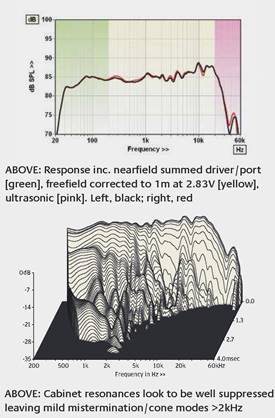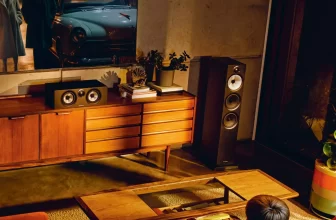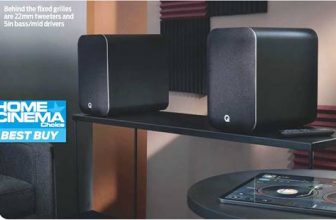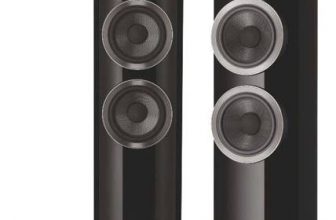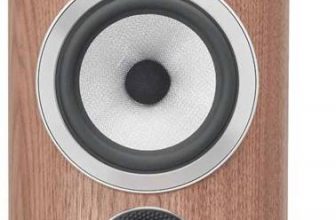AVID Reference Four Review
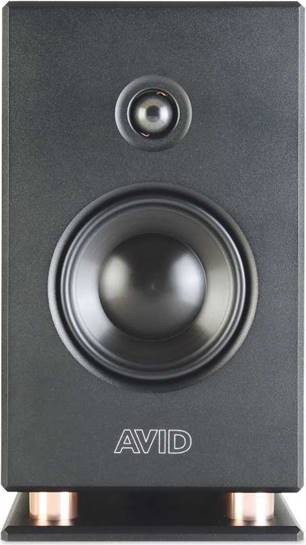
AVID’s ‘sledgehammer-to-crack-a-nut’ two-way features a massive all-alloy cabinet with tuned mass dampers to kill unwanted resonances – and this is the smallest in its range!
Review: Andrew Everard, Lab: Paul Miller
Made by: AVID Hi-Fi Ltd, Kimbolton, Cambs
Supplied by: AVID Hi-Fi Ltd
Telephone: 01480 869900
Web: www.avidhifi.co.uk
The friend who helped me unload these three AVID Hi-Fi boxes – one for each Reference Four speaker, at a pair, plus one for the included (and very hefty) stands – thought he’d nailed it. ‘What are these for, then?’ he asked, ‘heavy metal music?’. He wasn’t far off the truth for while most speakers do very nicely indeed with variations on the wooden box theme, the Reference Fours use all-alloy cabinets, with panels up to 15mm-thick, sitting on six ‘risers’ attached to a thick alloy baseplate. Hence why each of these relatively compact speakers, at just under 37cm tall, weighs 25kg.
Furthermore, the cabinets may only be 21cm wide, which is almost as narrow as they could be while still accommodating the 16cm-wide bass/mid drivers, but they’re also 44cm deep, meaning they’ll overhang most aftermarket stands. AVID has this predicament covered with its own supports, although fitting them to the speakers is something of a palaver. After assembling the stands, you must remove the baseplate from the speakers, bolt that to the stand, and then fix the baseplate back to the six riser feet again.
HE AIN’T HEAVY
This assembly stands just under a metre tall and totals 40kg per side, but with the centre of gravity up high, it doesn’t feel quite as topple-proof as it might. I’m loathe to suggest the stands should be heavier still, but perhaps they could have done with an even weightier footplate?
With their big ticket, it may come as a surprise to learn that the Fours are actually the entry-level model in AVID’s Reference range. This British company is best-known for its vinyl replay products [HFN Sep ’20, Nov ’20 and Apr ’21], which allows the brand to offer a complete system from LP to amplification [HFN Dec ’21] to speakers. Above the Reference Four sits the larger Reference Three standmount (and stands) before we move on to the
‘Rhythms motor along without a hint of blur’
Reference Two floorstanders and the Reference Active Sub. The Reference One flagship, standing almost two metres tall and weighing 340kg apiece. Now that is heavy metal!
RELEGATING RESONANCE
As with all the range, the Reference Four’s enclosure is machined and constructed in-house at the company’s Cambridgeshire base, using aerospace-grade aluminium plates and with all fixings concealed. Resonance control is a feature of the alloy construction, and so AVID side-steps the stuffing and bracing we might see in a conventional wooden cabinet.
The thick aluminium alloy assembly offers an innate rigidity while the drivers are fixed in place with O-ring seals and compression plates, designed to spread the clamping force around the entire circumference of the driver’s basket. Not for AVID a handful of bolts… Furthermore, tuned mass dampers are mounted via decoupling assemblies to the rear of the drivers, soaking up unwanted vibration before it leaves the unit itself, thus removing the need for further cabinet treatment [see PM’s boxout, p71].
RIGHT: AVID’s diagonally- braced cabinet comprises 15mm-thick alloy panels and hosts a 160mm polymer- coned bass/mid driver with 28mm silk-dome tweeter, both sourced from Morel
That thinking also informs the design of the bass-tuning port that vents downward into the space created by those riser feet and onto a cone-shaped diffuser mounted on the baseplate. This distributes the port output over a full 360o, AVID claiming a superior 30Hz bass extension and reduced sensitivity to room placement versus a conventional rear-mounted port.
The drivers themselves are sourced from Morel, the 28mm silk-dome tweeter shared across the Reference range and featuring a dome treated with ‘Acuflex’. As the name suggests, this is claimed to promote ‘accurate flexing’, where break-up modes are counteracted by others working in the opposite direction. The tweeter is powered by a neodymium magnet and 28.6mm ‘Hexatech’ (honeycomb) aluminium voice coil on a titanium former. Furthermore, the coil winding height is shorter than the magnetic gap so it remains within the magnetic field at all times, improving transient response. Finally, the tweeter is mounted behind a short flare on the alloy baffle to improve its off-axis behaviour.
AUDIOPHILE COMPONENTS
The partnering 16cm bass/mid driver uses a damped polymer composite cone mounted in a ‘Uniflow’ basket, this designed using aerodynamic principles to smooth the airflow behind. Meanwhile the crossover uses ClarityCap capacitors, as in all the
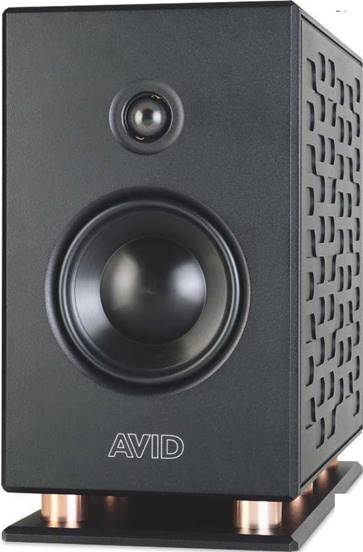
LEFT: Cylindrical risers lift the downward-firing port clear of the baseplate that includes a diffuser to moderate and ‘spread’ the port output
Reference speakers, along with ‘Copper Connect’ technology for reduced signal path resistance. Similarly, the air-core inductors are wound with 1.25mm-thick enamelled copper wire, its low DC resistance promising better bass control.
AVID’s notes for positioning the speakers are fairly general. It suggests you start with them slightly closer together than they are from the listening position – some 45cm from the rear wall – pointing out that too close will boost the bass but may impact on clarity and stereo image. It also advises they are well in from side walls, then ‘adjust until you are happy with the sound’. A slight toe-in is recommended – ‘pointing slightly toward, but not directly at, the listening position’ – as this will give the best trade-off between stereo imaging and enough spread for several listeners. It’s good to see a manufacturer proposing hi-fi as a social experience!
TUNING OUT
US brand Magico has also carved a niche with its all-alloy cabinets, but controls resonances not only with comprehensive internal bracing, but by using a type of constrained layer damping. Here a very ‘lossy’ polymer layer is sandwiched between alloy panels, or a brace and panel, to convert and ‘lose’ vibration more effectively to heat. AVID, instead, tackles the issue of unwanted cabinet resonances at source – the drivers themselves. Specifically, it has adapted a well- known engineering principle called ‘tuned mass damping’, in which specifically dimensioned and positioned masses act to suppress resonance. The ‘mass’ is seen here in action [red, inset pic] clamped to the bass/ mid driver magnet via two decoupled risers. You can just see the decoupling elements in green. Incidentally, a similar technique is used on a grand scale to protect high rise buildings in earthquake zones!
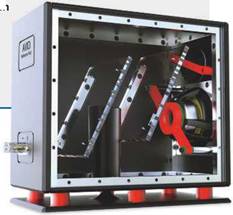
OLD MEETS NEW
With a little jiggling, those suggestions seemed to work well for me, and after some experimentation with different amplification, I settled on my ‘vintage’ Naim set-up of NAC52/52PS/NAP250 [HFN Jan ’14], connected to the Reference Four’s substantial single-wire terminals using runs of Naim NAC A5 cable. While the speakers needed the preamp to be turned up a bit to achieve decent SPLs [see PM’s Lab Report, p73], this was no problem – as with all Naim amps, this combination really seems to get into its stride at higher levels, and drove the speakers with plenty in reserve to accommodate musical dynamics.
From the off, several things immediately grabbed me about the sound of the Reference Four loudspeakers. Namely, the crisply-focused, expansive soundstage ‘picture’ they create; the weight and control of the bass; and the speed with which they react to the music, enhancing detail and ensuring rhythms motor along without a hint of blur or overhang. Play a punchy track such as New Order’s ‘Blue Monday’, from the Total compilation [Rhino 5052498647958], with its thumping bass line threatening to swallow all before it, and the Fours steal none of the weight while still casting an image of excellent & clarity, in which every musical element is just so easy to follow.
Even with the mayhem of some vintage KLF tracks, courtesy of the recent Arkive download release [The KLF; n/a cat. no.], which trawls out some early demos and unreleased mixes, there’s that same combination of deft, well-extended bass and masses of information. The music simply powers out of the Fours as it really shouldn’t from speakers this small. Big, thundering low frequencies, allied to plenty of detail – spot those contentious samples – what more could one want?
AUTHENTIC TO THE CORE
However, you don’t have to be crashing out electronica to appreciate what the Reference Fours can do as they’re just as convincing with orchestral, chamber or jazz recordings. They delivered a well- scaled view of the ‘band’ on Sonoko Miriam Welde’s recording of the Bruch Violin Concerto [Lawo Classic LWC 1222; DXD] while keeping the soloist naturally focused before the listener, and conjuring up an exciting sense of performance. All this and with the bite of the violinist’s strings set against the palpable weight of the orchestra behind her.
Similarly with the sparse sound of baritone James Rutherford’s reading of Schubert’s Winterreise [BIS BIS- 2410], recently released more than three years after it was recorded.
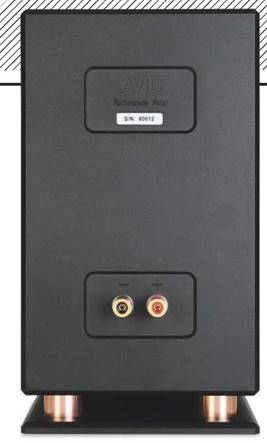
LEFT: Two very substantial 4mm cable binding posts connect to a simple four- element, 2nd-order crossover
Here its absolute focus on the voice and piano really grabs the listener’s attention with its chilly ambience – despite being recorded in August in sunny Suffolk!
Staying with events in that county, the Fours do a fine job with the 2020 Bergen Philharmonic/ Edward Gardner recording of Britten’s Aldeburgh-set Peter Grimes [Chandos CHSA 5250; DSD 64]. Yes, in absolute terms I could have done with a little more bass growl and weight for that celebrated ‘Storm’ interlude, but for speakers so small what’s on offer is still mighty impressive. In the context of an unfolding drama whose every nuance and twist is illuminated by the levels of insight these loudspeakers deliver, the loss of that last iota of room-shaking ability is a very minor concession.
In practice, those crashing, wind-tossed waves are certainly tumultuous enough considering the diminutive size of the speakers unleashing them, as is the way the Reference Fours portray the unearthly nature of the despairing conclusion to the piece. These are speakers to grab the listener and command attention, and they do that regardless of the musical genre being played.
VERDICT
With their tank-like build and equally hefty price-tag, AVID’s Reference Fours feel anything but an entry-level model. They reward both the considerable design and engineering effort put into them, and the heavy lifting involved in getting them set up, with a sound of remarkable power, insight and involvement. If you must have small speakers to represent a big system, then these alloy sculptures are a superb choice.
SPECIFICATIONS
| Sensitivity (SPL/1m/2.83V – 1kHz/Mean/IEC) | 85.5dB / 85.3dB / 82.9dB |
| Impedance modulus: minimum & maximum (20Hz-20kHz) | 6.28ohm @ 168Hz 47ohm @ 66Hz |
| Impedance phase: minimum & maximum (20Hz-20kHz) | -54o @79Hz +46o @55Hz |
| Pair matching/Resp. error (200Hz-20kHz) | 1.05dB/ ±3.2dB/±3.0dB |
| LF/HF extension (-6dB ref 200Hz/1 0kHz) | 29Hz / 25.7kHz/26.1kHz |
| THD 100Hz/1kHz/10kHz (for 90dB SPL/1m) | 0.7% / 0.55% / 0.5% |
| Dimensions (HWD) / Weight (each) | 367x210x440mm / 25kg |
LAB REPORT – AVID REFERENCE FOUR
While most of the ‘reactive action’ takes place through the bass (sub-200Hz) with swings in phase angle of -54o/79Hz and +46o/55Hz (all >15ohm), the Reference Four’s minimum impedance is an ‘easy’ 6.3ohm/168Hz. Beyond this the modulus continues to rise, reaching 8ohm at 415Hz and 14.8ohm/20kHz (there’s an inconsequential ‘dip’ to 10ohm/+11 o/1.6kHz). So AVID’s Reference Four is a very gentle load for the partnering amplifier, a quality traded, in part, for its slightly lower-thanaverage sensitivity of 85.5dB/1 kHz (or 85.3dB from 500Hz-8kHz) – rather less than the optimistic 88dB specification.
The reward comes in a generally flat response, peaking slightly in the mid and high treble [see Graph 1, below], with errors of just ±1.2dB and ±1.1dB from 500Hz-8kHz (±3.2dB from 200Hz-20kHz) and a fine pair matching of 0.6dB from 200Hz- 10kHz. The 160mm polymer-coned woofer reaches across 53Hz- 790Hz (-6dB), augmented by a downward-firing port tuned, sharply, to 31Hz. This delivers an impressive, diffraction-corrected bass extension of 29Hz (-6dB re. 200Hz), but very low bass rolls away steeply [green infill, Graph 1 ]. The partnering 28mm doped silk dome tweeter extends almost precisely to 20kHz before rolling away just as steeply to ~26kHz (-6dB re. 10kHz). While this renders the Reference Four moot (mute?) to ‘hi-res’ audio, and while very mild midrange resonances are visible in the CSD waterfall [Graph 2], the lack of any ultrasonic dome break-up ensures the speaker’s impulse response is exceptionally clean. Distortion, too, is held to a consistent, and consistently low, ~0.5% through mid and treble (all re. 90dB SPL/1m). PM
